Preservation in the Age of Urbanization

On October 29, 2019, the Urban Land Institute (ULI) hosted a panel discussion in downtown Los Angeles, on 'Preservation in the Age of Urbanization'. The panel was comprised of Zoltan Pali, FAIA, the Founder and Design Principal of SPF:architects, Adrian Scott Fine, the Director of Advocacy at the Los Angeles Conservancy, Ken Bernstein, the Principal City Planner at the Office of Historic Resources, and David Abasta, Development Director at Gaw Capital USA. The speakers discussed their strategies for the future of preservation in Los Angeles, and the importance of preemptive cultural conservation in such a young city. As one of the largest 'melting pots' in the country, Los Angeles is defined by those who live here today and those who came before. This intermixing between the old and new will continue to shape the growth of the city and should be recognized it increasingly urbanizes.
Historic Conservation in Los Angeles
The Los Angeles Conservancy was founded in 1978 as a nonprofit membership organization to support education and advocacy for historic preservation and cultural conservation in Los Angeles. With about 5,700 members and a staff of 19, the Conservancy is tasked with ascertaining and safeguarding Los Angeles’ historical and cultural landmarks in all 88 cities within the county. In the past, the Conservancy admits they were more focused on icons at risk. However, the team has evolved to be more nuanced with their work and now emphasize neighborhood character development through policies and planning. Speaking on the evolution of the Conservancy, Adrian Scott Fine explained, “It's always something that we struggle with, the balance between reaction, which is kind of the nature of the beasts that we are, and trying to do more of the proactive side of things.” While architectural significance is still a factor, it is no longer the driving factor, as preservationists have expanded their criteria to encompass the stories of individuals and groups who have contributed to the character of the city. Indeed, the conservancy has progressed to a more holistic approach when advocating for landmarks.
At a time when no one believed there would be interest in preserving downtown Los Angeles, the Department of City Planning’s Office of Historic Resources (OHR) advocated for the restoration of its historic core with the support of the Conservancy Central City Association and other groups. Referred to as the Broadway Initiative, it focused on promoting the adaptive reuse of Broadway Boulevard and the Historic Theaters District. The Adaptive Reuse Ordinance would not be approved until the following year, so the Broadway Initiative was foundational to downtown's progression. Within 10 years, about 9,000 new housing units were developed, and the perception of the livability of the area drastically changed. Taking a broader advocacy approach helped facilitate the reuse of the entire neighborhood as well as reestablish its character for the benefit of the community.

SurveyLA
In 2010, with the conception of SurveyLA, the OHR has been able to expand the scope of its projects throughout Los Angeles more easily. Created as a collaboration between the city and the J. Paul Getty Trust, SurveyLA collects historic resources from all 35 community plan areas of the city. The information from the surveys is available to the public with the purpose of providing baseline knowledge for planners to help inform long-range planning recommendations, project reviews, and development communities making investments in historic properties. Ken Bernstien discussed the future of SurveyLA saying, “Part of the future of SurveyLA is that we really want to use it actively, and we’re spending a lot of time doing that within our planning department. One of the things we’ve been doing recently is now we finally have the funding, staffing, and resources to update a lot of our community plans, and we’re working very closely with the planners and, in some cases, the community groups in those areas.”
The OHR hopes to capitalize on the information provided by the survey to support better planning and create a framework for further historical research and analysis in Los Angeles. Through SurveyLA and preservation efforts, the story of Los Angeles will remain for future generations as a reminder of the past that shaped the city today. However, as we continue to preserve the past, how do we share the story of our present and plan for the future of architecture?
Blending the New with the Old
Zoltan Pali exemplifies this idea with the Wallis Annenberg Center for the Performing Arts at the intersection of Santa Monica Boulevard and Crescent Drive. This historic intersection boasts the 1932 Spanish Renaissance-style Beverly Hills City Hall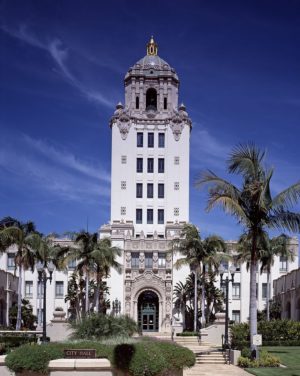 , the 1990 addition of the Postmodern and Spanish-Art Deco hybrid Civic Center
, the 1990 addition of the Postmodern and Spanish-Art Deco hybrid Civic Center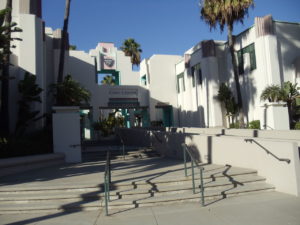 designed by Charles Moore, and the Mid-century modern Union 76 Gas Station
designed by Charles Moore, and the Mid-century modern Union 76 Gas Station designed in 1965 by Gin Wong. Pali converted the Historic Beverly Hills Post Office from 1934, into a state-of-the-art theater in 2013.
designed in 1965 by Gin Wong. Pali converted the Historic Beverly Hills Post Office from 1934, into a state-of-the-art theater in 2013.
With the history of the building in mind, his challenge was to transform the site while preserving the character of the landmark. Pali proposed a studio theater in the 2,000-square-foot mailroom with offices above, an additional wing to hold the plan’s auxiliary elements, and a new 500-seat theater. This allowed for greater focus on the rehabilitation of the post office and the incorporation of a new contemporary building to frame the context of the old.

Pali commented on the design saying, “I knew there was no way that I would be the kind of architect that was correct for making something that blends in or is architecturally referential to the existing building. I didn’t believe in that and I don’t believe that that’s the proper thing to do actually. We tried to do something much bigger and bolder and that ultimately won the day. I wove a story about what happened on the site and what was a reference to the culture on the site, and the culture on the site really was the incoming mail and the dissemination of mail on the site and really the facade of the building is nothing more than the abstract representation of that; mail slots and letters and envelopes.”

The design of the skin (made up of cement panels) on the new theater represents the abstraction of envelopes that were once so significant to the identity of the property, while the copper color references the terracotta frieze of the original building. When considering the present and future of a historic site, Pali remarked, “It’s just not about copying an architectural element, it's really about trying to go deeper into what has happened culturally on the site; What you see happening in the future as well, and trying to straddle the past, present, and future. It's akin to a little bit of songwriting or story writing, but that’s what it comes down to for me.”
The Future of Preservation
Bernstien argues that the approach to contemporary architecture with historic buildings has evolved over the last 20 years to accommodate current needs and living standards. Referring to Rem Koolhaas' addition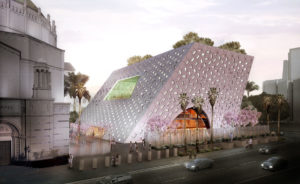 to the historic Wilshire Blvd Temple
to the historic Wilshire Blvd Temple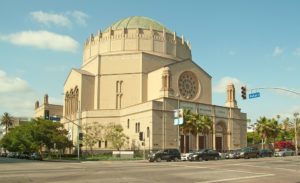 , he said, “We brought it to the attention of our Cultural Heritage Commission last year and I really didn’t know how our commissioners would react to that. I got comfortable with it as we looked at the design, but our commissioners embraced it unanimously, embraced the new design on that site and no objections to it.”
, he said, “We brought it to the attention of our Cultural Heritage Commission last year and I really didn’t know how our commissioners would react to that. I got comfortable with it as we looked at the design, but our commissioners embraced it unanimously, embraced the new design on that site and no objections to it.”
The addition takes inspiration from the historic building while beginning a new contemporary chapter in design. By blending the past with the present, architects are better able to contribute to the history and future of the city. Often preservationists are misjudged for being unwilling to reform. Nevertheless, the panel agreed that the future of preservation depends on its ability to adapt to societal shifts.
You Don’t Have to Go Home but You Can’t Stay Here
As preservation evolves, it must also address the role of legacy businesses. Although a historic building is protected, the use of the building is not, even if that business has been long associated with the site. If the use is gone, the historic designation cannot bring it back. Fortunately, San Francisco is leading the protection of legacy businesses with the Legacy Business Registry, a taxpayer-funded subsidy program that promotes “business-friendly” policies, the marketing of the small business sector, and assistance programs. Both the Small Business Commission and Office of Small Business help to support the growth and preservation of small business in the city. On the discussion of legacy businesses, Bernstien commented, “...historic preservation can evolve to be broader in thinking about how we protect the people, and the institutions. That doesn’t necessarily mean new regulatory tools or new designation tools, but maybe it's more about incentives and partnerships to make that possible.”
When discussing legacy businesses, the panelists agreed it's not a “one size fits all” solution. Often because of the long-standing history of the businesses, people have connections and experiences with them and care about their future. The Formosa Cafe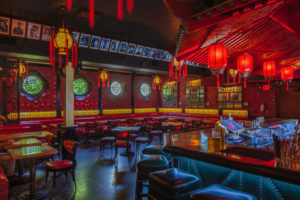 is an example of a legacy business that went out of business until a new owner brought it back to what it was originally. So, the key to promoting interest in the preservation of legacy businesses is to encourage interest in historic properties and create tax incentives so people feel more inclined to take action.
is an example of a legacy business that went out of business until a new owner brought it back to what it was originally. So, the key to promoting interest in the preservation of legacy businesses is to encourage interest in historic properties and create tax incentives so people feel more inclined to take action.
Likewise, it's important we consider incentives for the future of affordable housing on historic properties. Many legacy businesses are subject to rent increases and often can’t afford to renovate their properties to historic standards. In the discussion of the future of preservation, Scott Fine added, “The other piece I would throw out is that when you’re talking about relevancy in the future, we need to be more at the table in terms of talking about issues that are relevant to everyday people’s lives, like housing. I do believe we are a part of the solution, but we are also a part of the challenges in terms of how to address a really weighty issue providing affordable housing. Most affordable housing in LA is in old or historic buildings. So we need to be part of that, and think about how do you create incentives for owners of those buildings so they can make the necessary upgrades, but also how do you retain them?”
The Mills Act Program
The Mills Act Program is one such financial incentive program for owners of historic properties to save between 20 and 80% in property taxes in exchange for a 10-year commitment to preserve their historic structure. The OHR has worked to implement incentives that are an indirect public subsidy for property owners that have demonstrated the greatest amount of need for rehabilitation work. Recently they have created guidelines for multifamily projects to demonstrate their commitment to affordable housing. Bernstien commented, “We feel it's important that the subsidy is not only benefiting single-family homeowners that have deep pockets and could be doing this rehabilitation work anyways, but trying to target homeowners of more limited means and projects that can have the greatest community impact.”
In addition, in January 2020, the new Historic State tax credit will launch. It is an income tax credit that will be available to property owners with nationally registered and California registered properties. Previously, the Federal Historic Rehabilitation tax credit was limited to only income-producing properties, but now it will extend to smaller properties and owner-occupied residences.
The Future
About 6% of Los Angeles is designated as historic, and preservationists want to encourage developers to allow the historic buildings to continue to adapt to contemporary living standards as the city evolves. By taking on a broader approach to preservation with the consideration of contemporary additions, climate heritage, legacy businesses, and incentives, preservationists are ensuring a bright future for Los Angeles. Abasta sums up the future of preservation saying, “The challenge with contemporary architecture is the challenge of innovating, and you want to push that as a lover of architecture, a lover of cities, a lover of places, while still balancing that with the demands of the market.”
Architecture surrounds our lives. It conveys the history of society and represents the culture and stories of its time. As the world is constantly changing, architecture is an enduring reminder of the people and communities that have brought us to where we are today. Without preservation, all of that would be forgotten.







